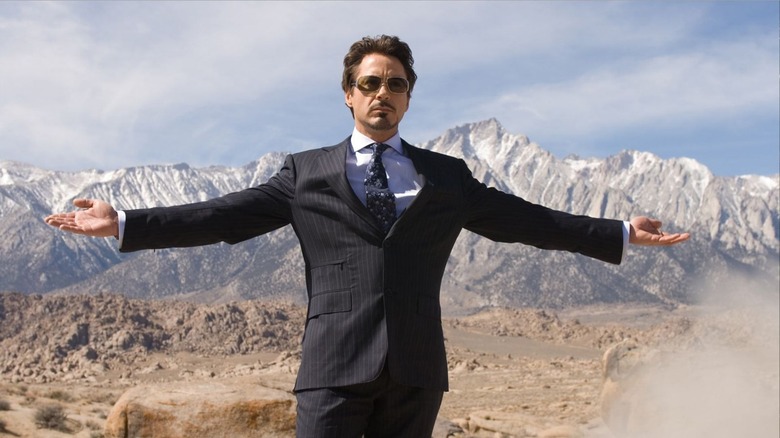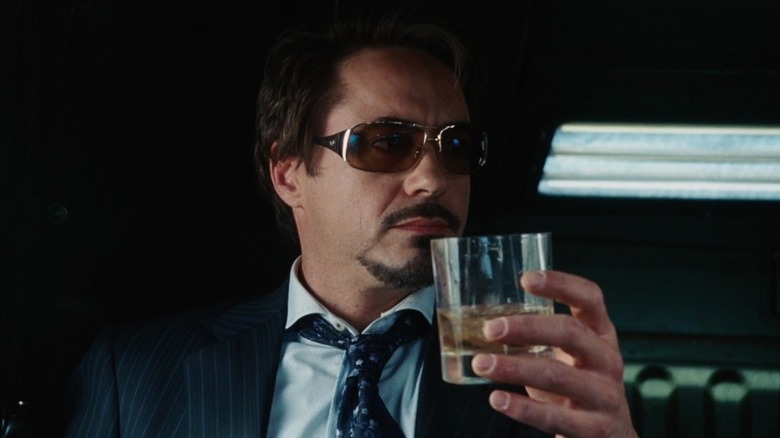Robert Downey Jr. Gave Tony Stark Sunglasses So He Could Read Cue Cards In Iron Man
Thanks to the longstanding dominance of the Marvel Cinematic Universe, most mainstream audiences could recite the origin story of Tony Stark, aka Iron Man (Robert Downey, Jr.), as if it was holy writ: Tony, a selfish, amoral weapons manufacturer, is kidnapped during a missile presentation in Afghanistan. He is forced by his kidnappers to build weapons and explosives, but instead, with the help of Ho Yinsen (Shaun Toub), builds a suit of high-tech attack armor. He escapes, but loses his friend in the skirmish, breaking his heart. Thereafter, Tony has an attack of conscience, drops out of the weapons game, and uses a rocket-powered Iron Man suit to fly around the world and destroy Stark Industry weapons.
Had the MCU ceased with "Iron Man," it still would have been a marvelously satisfying story. A tale of heroic redemption featuring an aspirational hero who devoted himself to disarmament.
The start of the "Iron Man" story was the above-mentioned missile presentation, back when Tony was still eager to sell weapons and show off his company's destructive capabilities. In true corporate fashion, Tony gave a speech about the power of his new products, intoning, "Is it better to be feared or respected? I say: why not both?"
Downey, Jr. wanted that line to feel orchestrated, but also kind of off-the-cuff. In a video interview with Vanity Fair, the actor revealed that the speech was printed on cue cards, allowing him to give the scene an improvised feel. However, in order to hide the fact that he was reading from said cue cards, Downey, Jr. decided to give Tony a pair of sunglasses. It was a practical choice, but the sunglasses became a permanent part of Tony's look in all the subsequent "Iron Man" sequels.
Tony Stark's sunglasses
Indeed, Tony's sunglasses became the central plot point of the 2019 film "Spider-Man: Far From Home." After Tony's death in "Avengers: Endgame," he bequeathed his shades to the teenage Peter Parker, aka Spider-Man (Tom Holland). What Peter didn't know is that the sunglasses were equipped with a high-tech artificial intelligence that allowed him to access a series of spacebound assassination missiles that Tony had built. It seems Tony went back on his promise of disarmament.
Back in "Iron Man," though, there were no such bells and whistles attached to Tony's shades. They were merely a practical acting decision so that audiences wouldn't notice Downey, Jr.'s eyes swiveling over his lines. As the actor explained:
"There's a scene where he is doing a weapons test, and he says, 'Is it better to be feared or respected? Is it too much to ask for both?' And [director] Jon [Favreau] and I were literally writing that line for line as we went along shooting it that day. And I put on sunglasses because it was all on cue cards. [...] It's more important that we feel like we're just coming up with this, and we like it, and there's no trick we can't employ to cover the fact that we're kind of making it up as we go along."
Given how massively over-orchestrated the MCU would become, it's astonishing to think that "Iron Man" involved an element of winging it. Indeed, Favreau has even said in interviews that the famous "Avengers" tease after his film's credits was a mere wink to fans, and not a declaration of intent for a cinematic universe. It wouldn't be until Disney purchased Marvel in 2009 that such plans would be firmly put into place.

